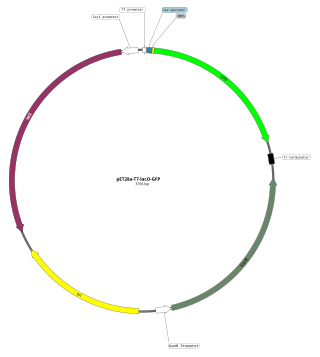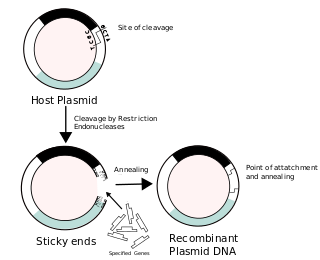Related Research Articles

A genetically modified organism (GMO) is any organism whose genetic material has been altered using genetic engineering techniques. The exact definition of a genetically modified organism and what constitutes genetic engineering varies, with the most common being an organism altered in a way that "does not occur naturally by mating and/or natural recombination". A wide variety of organisms have been genetically modified (GM), including animals, plants, and microorganisms.

Genetic engineering, also called genetic modification or genetic manipulation, is the modification and manipulation of an organism's genes using technology. It is a set of technologies used to change the genetic makeup of cells, including the transfer of genes within and across species boundaries to produce improved or novel organisms.

A DNA vaccine is a type of vaccine that transfects a specific antigen-coding DNA sequence into the cells of an organism as a mechanism to induce an immune response.

An expression vector, otherwise known as an expression construct, is usually a plasmid or virus designed for gene expression in cells. The vector is used to introduce a specific gene into a target cell, and can commandeer the cell's mechanism for protein synthesis to produce the protein encoded by the gene. Expression vectors are the basic tools in biotechnology for the production of proteins.

Recombinant DNA (rDNA) molecules are DNA molecules formed by laboratory methods of genetic recombination that bring together genetic material from multiple sources, creating sequences that would not otherwise be found in the genome.
Pharming, a portmanteau of "farming" and "pharmaceutical", refers to the use of genetic engineering to insert genes that code for useful pharmaceuticals into host animals or plants that would otherwise not express those genes, thus creating a genetically modified organism (GMO). Pharming is also known as molecular farming, molecular pharming or biopharming.
A biopharmaceutical, also known as a biological medical product, or biologic, is any pharmaceutical drug product manufactured in, extracted from, or semisynthesized from biological sources. Different from totally synthesized pharmaceuticals, they include vaccines, whole blood, blood components, allergenics, somatic cells, gene therapies, tissues, recombinant therapeutic protein, and living medicines used in cell therapy. Biologics can be composed of sugars, proteins, nucleic acids, or complex combinations of these substances, or may be living cells or tissues. They are isolated from living sources—human, animal, plant, fungal, or microbial. They can be used in both human and animal medicine.

Nicotiana benthamiana, colloquially known as benth or benthi, is a species of Nicotiana indigenous to Australia. It is a close relative of tobacco.
A transgene is a gene that has been transferred naturally, or by any of a number of genetic engineering techniques, from one organism to another. The introduction of a transgene, in a process known as transgenesis, has the potential to change the phenotype of an organism. Transgene describes a segment of DNA containing a gene sequence that has been isolated from one organism and is introduced into a different organism. This non-native segment of DNA may either retain the ability to produce RNA or protein in the transgenic organism or alter the normal function of the transgenic organism's genetic code. In general, the DNA is incorporated into the organism's germ line. For example, in higher vertebrates this can be accomplished by injecting the foreign DNA into the nucleus of a fertilized ovum. This technique is routinely used to introduce human disease genes or other genes of interest into strains of laboratory mice to study the function or pathology involved with that particular gene.
This page provides an alphabetical list of articles and other pages about biotechnology.

Viral vectors are tools commonly used by molecular biologists to deliver genetic material into cells. This process can be performed inside a living organism or in cell culture. Viruses have evolved specialized molecular mechanisms to efficiently transport their genomes inside the cells they infect. Delivery of genes or other genetic material by a vector is termed transduction and the infected cells are described as transduced. Molecular biologists first harnessed this machinery in the 1970s. Paul Berg used a modified SV40 virus containing DNA from the bacteriophage λ to infect monkey kidney cell maintained in culture.

Biotechnology is the use of living organisms to develop useful products. Biotechnology is often used in pharmaceutical manufacturing. Notable examples include the use of bacteria to produce things such as insulin or human growth hormone. Other examples include the use of transgenic pigs for the creation of hemoglobin in use of humans.

Genetically modified plants have been engineered for scientific research, to create new colours in plants, deliver vaccines, and to create enhanced crops. Plant genomes can be engineered by physical methods or by use of Agrobacterium for the delivery of sequences hosted in T-DNA binary vectors. Many plant cells are pluripotent, meaning that a single cell from a mature plant can be harvested and then under the right conditions form a new plant. This ability is most often taken advantage by genetic engineers through selecting cells that can successfully be transformed into an adult plant which can then be grown into multiple new plants containing transgene in every cell through a process known as tissue culture.
A subunit vaccine is a vaccine that contains purified parts of the pathogen that are antigenic, or necessary to elicit a protective immune response. Subunit vaccine can be made from dissembled viral particles in cell culture or recombinant DNA expression, in which case it is a recombinant subunit vaccine.
A neutralizing antibody (NAb) is an antibody that defends a cell from a pathogen or infectious particle by neutralizing any effect it has biologically. Neutralization renders the particle no longer infectious or pathogenic. Neutralizing antibodies are part of the humoral response of the adaptive immune system against viruses, intracellular bacteria and microbial toxin. By binding specifically to surface structures (antigen) on an infectious particle, neutralizing antibodies prevent the particle from interacting with its host cells it might infect and destroy.

Molecular cloning is a set of experimental methods in molecular biology that are used to assemble recombinant DNA molecules and to direct their replication within host organisms. The use of the word cloning refers to the fact that the method involves the replication of one molecule to produce a population of cells with identical DNA molecules. Molecular cloning generally uses DNA sequences from two different organisms: the species that is the source of the DNA to be cloned, and the species that will serve as the living host for replication of the recombinant DNA. Molecular cloning methods are central to many contemporary areas of modern biology and medicine.
Recombinant antibodies are antibody fragments produced by using recombinant antibody coding genes. They mostly consist of a heavy and light chain of the variable region of immunoglobulin. Recombinant antibodies have many advantages in both medical and research applications, which make them a popular subject of exploration and new production against specific targets. The most commonly used form is the single chain variable fragment (scFv), which has shown the most promising traits exploitable in human medicine and research. In contrast to monoclonal antibodies produced by hybridoma technology, which may lose the capacity to produce the desired antibody over time or the antibody may undergo unwanted changes, which affect its functionality, recombinant antibodies produced in phage display maintain high standard of specificity and low immunogenicity.
Transient expression, more frequently referred to "transient gene expression", is the temporary expression of genes that are expressed for a short time after nucleic acid, most frequently plasmid DNA encoding an expression cassette, has been introduced into eukaryotic cells with a chemical delivery agent like calcium phosphate (CaPi) or polyethyleneimine (PEI). However, unlike "stable expression," the foreign DNA does not fuse with the host cell DNA, resulting in the inevitable loss of the vector after several cell replication cycles. The majority of transient gene expressions are done with cultivated animal cells. The technique is also used in plant cells; however, the transfer of nucleic acids into these cells requires different methods than those with animal cells. In both plants and animals, transient expression should result in a time-limited use of transferred nucleic acids, since any long-term expression would be called "stable expression."
An edible vaccine is a food, typically plants, that contain vitamins, proteins or other nourishment that act as a vaccine against a certain disease. Once the plant, fruit, or plant derived product is ingested orally, it stimulates the immune system. Specifically, it stimulates both the mucosal and humoral immune systems. Edible vaccines are genetically modified crops that contain antigens for specific diseases. Edible vaccines offer many benefits over traditional vaccines, due to their lower manufacturing cost and a lack of negative side effects. However, there are limitations as edible vaccines are still new and developing. Further research will need to be done before they are ready for widespread human consumption. Edible vaccines are currently being developed for measles, cholera, foot and mouth disease, Hepatitis B and Hepatitis C.
A genetic vaccine is a vaccine that contains nucleic acids such as DNA or RNA that lead to protein biosynthesis of antigens within a cell. Genetic vaccines thus include DNA vaccines, RNA vaccines and viral vector vaccines.
References
- ↑ Amemiya, C. T.; Zilch, A.; Hinds-Frey, K. R.; Litman, R. T.; Roess, W.; Hulst, M.; Haire, R. N.; Shamblott, M. J.; Rast, J. P. (1993-01-01). "Phylogenetic diversification of immunoglobulin genes and the antibody repertoire". Molecular Biology and Evolution. 10 (1): 60–72. doi: 10.1093/oxfordjournals.molbev.a040000 . PMID 8450761.
- ↑ Goodsell, David S. (December 2001). "The Molecular Perspective: Antibodies" (PDF). The Oncologist. 6 (6): 547–548. doi:10.1634/theoncologist.6-6-547. PMID 11743216.
- ↑ Plantibody (antibody synthesized by plants), Springer Reference.
- ↑ Buyel, J.F.; Twyman, R.M.; Fischer, R. (July 2017). "Very-large-scale production of antibodies in plants: The biologization of manufacturing". Biotechnology Advances. 35 (4): 458–465. doi: 10.1016/j.biotechadv.2017.03.011 . PMID 28347720.
- 1 2 "Antibodies in plants" . Retrieved 6 November 2013.
- ↑ Daniell, Henry; Streatfield, Stephen J; Wycoff, Keith (May 2001). "Medical molecular farming: production of antibodies, biopharmaceuticals and edible vaccines in plants". Trends in Plant Science. 6 (5): 219–226. doi:10.1016/s1360-1385(01)01922-7. PMC 5496653 . PMID 11335175.
- ↑ Ayala, Marta; Gavilondo, Jorge; Rodríguez, Meilyn; Fuentes, Alejandro; Enríquez, Gil; Pérez, Lincidio; Cremata, José; Pujol, Merardo (2009). "Production of Plantibodies in Nicotiana Plants". Recombinant Proteins from Plants. Methods in Molecular Biology. Vol. 483. pp. 103–134. doi:10.1007/978-1-59745-407-0_7. ISBN 978-1-58829-978-9. PMID 19183896.
- ↑ Walmsley, Amanda M; Arntzen, Charles J (April 2003). "Plant cell factories and mucosal vaccines". Current Opinion in Biotechnology. 14 (2): 145–150. doi:10.1016/S0958-1669(03)00026-0. PMC 7135315 . PMID 12732315.
- ↑ "Plantibodies" . Retrieved 7 November 2013.